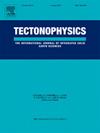Geological and geodetical vertical deformation profiles across the Kuradake fault group, Central Kyushu, SW Japan: Estimation of the proportion of triggered aseismic slip in the total late Quaternary slip
IF 2.7
3区 地球科学
Q2 GEOCHEMISTRY & GEOPHYSICS
引用次数: 0
Abstract
We investigated the Kuradake fault group, which includes the Matoishi-bokujo-I (MbI), Tsumushi-yama (Ty), and Matoishi-hatabe-III (MhIII) faults, on the northwestern rim of Aso caldera, SW Japan. To obtain the total vertical displacement since ca. 87 ka, we conducted a geological survey, borings, and seismic profiling, and to obtain the vertical displacement due to slip triggered by the 2016 Kumamoto earthquake (Mw = 7.0 on 16 April 2016), we conducted interferometric synthetic aperture radar (InSAR) monitoring. In 10 arrayed borings along survey section Krdk 21 across the fault group, we recognized pre-Aso-2 (age unknown), Aso-2 (146 ka), Aso-3 (133–120 ka), and Aso-4 (ca. 87 ka) tephras, and additional pyroclastic flow/fall deposits. We reconstructed the Aso-4 flow depositional surface by subtracting the cover sediment thickness and estimated normal slips of 18–20 m and 15 m on the Ty and MbI faults, respectively. Triggered aseismic normal slips on the MhIII, Ty, and MbI faults during the 2016 earthquake determined by InSAR monitoring were 5–15, 13–15.5, and 14–21.5 cm, respectively. The slip amounts on the Ty and MbI faults are not compatible between the geological and geodetical observations. Further, because the geologically observed dextral slip component on the Ty fault was not observed by the InSAR monitoring, the observed slip on that fault is not related to 2016 event. Based on the geodetical slips on the Ty and MbI faults and the recurrence interval (2 ky) of the 2016 source (Futagawa fault) reported by paleoseismic studies, total vertical displacement since 87 ka was 5.7–6.8 m and 6.2–9.5 m, respectively, accounting for ≥ 29–38 % and ≥ 41–63 %, respectively, of the geological vertical displacement of the Aso-4 surface. The geologically expected oblique and additional normal slips on the Ty and MbI faults can account for the residual displacements.
求助全文
约1分钟内获得全文
求助全文
来源期刊

Tectonophysics
地学-地球化学与地球物理
CiteScore
4.90
自引率
6.90%
发文量
300
审稿时长
6 months
期刊介绍:
The prime focus of Tectonophysics will be high-impact original research and reviews in the fields of kinematics, structure, composition, and dynamics of the solid arth at all scales. Tectonophysics particularly encourages submission of papers based on the integration of a multitude of geophysical, geological, geochemical, geodynamic, and geotectonic methods
 求助内容:
求助内容: 应助结果提醒方式:
应助结果提醒方式:


